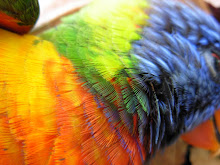
Ahh old Meeak the Moon Man... 15th November 2008
If there ever was one constant in our lives, besides the sun, it has to be the moon.
It isn't that we never look at the earth, but the earth is the familiar and years ago we didn't know it was 'the earth' and that it was 'round,' and that it was 'somewhere in space,' no we didn't know that, although we did know the 'sun was round' and beautiful in the dawn sky and sunset evening.
But we could never look at it for long and wonder...
Nah, that is why we were given the moon.
The moon has been that one constant, that one revered being, beside the sun, and beside Venus, and all the planets, and meteor showers, and comets... Ok, ok... how do I know what was revered and what wasn't... but it is just an idea isn't it?!
And we're allowed to have ideas even if they are proven wrong...
But I reckon the moon has been the most observed, the most revered and the most mused...
There sure are a lot of tales about him.
A lot of Noongar stories say that one shouldn't look at him.
And I wonder why this is so??
The old fella who taught me stuff said the old Noongar would say 'noonkar djinaang' - 'don't look,' and I think, the fear was that what lived inside of it would jump out and scratch your eyes out...
Sorry to tell you such things, because, for me, I like nothing but to look at the moon.
I even speak to him, 'kaya kongk' I say - 'hello uncle...' you know the yarn.
Now, I was just thinking... one time, myself and a number of archaeology students were excavating a house called Ellensbrook near Margaret River.
We had to pass a giant cave on our way there and this cave seemed an eerie place... The water from the stream swirled down the cave's mouth, and it resembled a giant mouth and throat of a yongka (western grey kangaroo) or something, its incisor tooth stood out where the water swirled down... anyway, not wanting to ramble on... it was in this cave or the other side of it that was known as Meekadaaribee: 'place where the moon bathes...' And it was here that two Noongar childhood sweethearts played together.
Now this is a story of the Wodarn-ngat Nyoongar of the south-coast.
And I tell it from what I have read, and through having been there and lastly, and most importantly, I tell it out of my respect for friendships with Noongar Webbs, Harris, and Isaacs families of the lower south coast.
Maybe it was their people who were the main contributors and actors of this story...no doubt...
Now in the cave these children played and one day, one of them, the younger girl, 'Mittan,' told her mother she had seen the moon bathing therein: "Mum, guess what I saw, you'll never guess..." (something like that...maybe) "...Meeak nidja kep yaaragat daaribiny...' might have been some of her words... And her mother, alarmed and troubled had spoken against looking at such things...saying bad luck would come to them if they did... and they did...look at that moon. Tell a child not to do something and they will do it.
"Hey!" "Don't look, but there is a car full of police following us" and nine times out of ten, all and everyone in the car will look and strain to look over their shoulders... "What did I just tell you fellas"... and nine times out of ten, that blue light will flash and the siren will wail...
Anyhow, they grew older, and in time, Mittan was promised and then given to an older man and her childhood friend 'nop' or as the story says, (Nop-el) Nobel... refused to accept their union and threw spears at the old man and was killed (or something like that).
Mittan, when the news reached her, was heartbroken.
Mittan then despaired, and refused to eat, and growing thin, like the moon grows thin, she died.
She died, it was written, out of love for her childhood sweetheart Nobel, and it is also written that their spirits can be heard in the gurgling of the waters of that cave today.
So if you ever get the chance to visit Meekadaaribee where the moon bathes have a look... but not at that full moon in the water...



